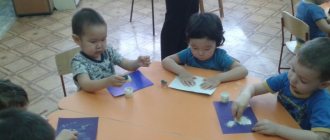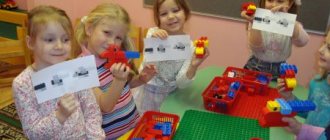Organization of walks and trips outside the preschool in the summer
Author: Nemilova Tamara Aleksandrovna
One of the ways for children to understand the world around them and themselves in it will be walks - hikes, excursions, targeted walks. Natural conditions will give preschoolers a lot of impressions and will contribute to the improvement of movement. Targeted walks and excursions are also organized to intersections, traffic lights, pedestrian crossings, road signs, city attractions, the library, post office, etc.
In the summer, much attention is paid to all kinds of targeted walks and trips outside the kindergarten territory with children of senior preschool age. These could be walks:
-to the meadow (“From dawn to dawn, summer walks through the meadows”, “Green Pharmacy”);
-to the river (“In the river kingdom, in the coastal state”);
-in a square, park (“Love and know your native land”), etc.
Target
Such
walks
are to contribute to the mental, moral, aesthetic and physical education of preschoolers based on the material of the natural environment, to develop curiosity and the ability to be surprised. With the help of an adult, children learn to establish simple patterns and understand the interconnections of natural phenomena. On each walk, the teacher teaches to notice, observe interesting natural phenomena, perceiving the world around them with all the senses, and develops in children the ability to admire the green grass, blue sky, white clouds, enjoy the singing of birds, and the buzzing of insects. Anticipation of the upcoming walk and the walk itself create a joyful mood in the child.
During the walk, it is useful to use a variety of didactic games, for example: “Guess the flower by description”, “Recognize the tree by the leaf”, “Pathfinders”. Observations can be accompanied by songs, riddles, reading short stories and poems. Children really enjoy composing their own riddles, poems, and fairy tales about flowers, insects, and phenomena that occur in nature in the summer. Preschoolers will be interested in learning folk signs.
You can organize a competition “Who will notice the most interesting and unusual things around.” Take a camera with you and take pictures of the children and what they observe as you walk. After returning from a walk, students should be given the opportunity to exchange observations, draw their impressions, make crafts from natural materials that can be used to decorate the kindergarten area, and arrange an exhibition of children's works. The knowledge acquired by children during a walk can be reflected in modeling, appliqué, collages, and children’s word creativity.
It is interesting to compile a book about summer walks that preschoolers will read, review, and show to their parents and peers from other groups. Teachers and children usually work on the text. The joint publication can be decorated with photographs and children's drawings.
In order for a walk outside the kindergarten to become not only useful, surprising, unique, but also safe for pupils, the teacher must follow the following basic rules:
- outline and check the route of a future walk in advance, inspect the area, the route of movement of pupils for the purpose of their safe stay outside the preschool educational institution;
- determine how natural conditions can be used to exercise children in different types of movements, where to properly organize rest, play, and observation;
- alternate types of activities depending on the plan for the walk to prevent overwork and overheating of pupils;
- take into account the physical capabilities of all children, prepare in advance for the walk beginners and preschoolers who are physically insufficiently prepared (doctor’s advice is required);
- organize walking walks with children, starting from the older group, for a distance of no more than 2 km, lasting 25–30 minutes one way (for the preparatory group – 40–45 minutes one way);
- inspect the clothes and shoes of pupils for compliance with weather conditions before the start of the target walk;
- stock up on fresh boiled water in sufficient quantities for children to drink, etc.
On the eve of the target walk, the head of the preschool educational institution issues an order, which stipulates the route, persons accompanying the children, and the number of preschoolers in the group. Those responsible for accompanying preschoolers undergo instruction with mandatory registration in the instruction log. Each walk-hike, targeted walk and excursion is preceded by preliminary work with preschoolers. Thus, the teacher not only conducts a series of conversations, games, and activities in which children receive the necessary information and master special terms, but also activates knowledge of traffic rules in case the route of a walk or hike crosses highways.
- Before a hike, excursion, or targeted walk, preschoolers are told the purpose of the upcoming activity in order to arouse their interest. Children should know where they will go, why, and what they will see.
- When preparing for a hike, excursion, or targeted walk, you need to pay attention to children’s clothing. Children should dress appropriately for the weather and season. The content of walks, hikes, targeted walks, excursions depends on the chosen topic. If the weather permits, the teacher can organize observations of insects, birds, and collection of natural material.
- On targeted walks, children’s attention is drawn to the beauty of the surrounding nature. Children enjoy the variety of smells, shapes, colors of leaves and flowers of plants. We make sure to introduce children to poisonous plants, mushrooms, berries, etc.
- Starting from the second youngest group, targeted walks are carried out, going outside the kindergarten site: to a pond, to a meadow, etc. On these walks, children are introduced to colorful natural phenomena. During walks, the teacher can introduce children to those natural phenomena, the idea of which takes a long time to develop.
- One type of activity to introduce children to nature is an excursion. During the excursion, the child can observe natural phenomena, seasonal changes in a natural setting, see how man transforms nature in accordance with the requirements of life and how nature serves people.
- Excursions are divided into natural history and agricultural. Natural history includes an introductory conversation, collective observation, individual independent children's research and collection of natural material, children's games with the material collected during the rest, the final part, where the teacher, summing up, draws the children's attention to the overall picture of nature.
- The main part of the excursion is collective observation. The main tasks are solved here. The teacher helps children notice and understand the characteristic signs of objects and phenomena. This is achieved using various techniques (questions, riddles, poems, survey activities, game techniques). The teacher supplements the observations with his story and explanation.
- It is useful to use children's fiction in the observation process. At the end of the main part, children must be given the opportunity to satisfy their curiosity in individual and independent observations and collection of natural history material. However, when giving the task to collect material, you should strictly limit its quantity in order to focus the children’s attention only on certain plants or animals, in addition, to solve the problem of caring for nature.
- During rest, the collected material is sorted, laid out, and used for games and exercises. In games: “recognize by smell”, “recognize by description”, “find a plant by leaf”, “branch, branch, where is your baby?” - children consolidate knowledge about the characteristic features of objects, express their quality in words, remember the names of plants and their parts.
- Agricultural excursions are varied: to the field, to the meadow, to the garden, to the vegetable garden, to the greenhouse, etc. Such excursions provide an opportunity to clearly show how humans influence nature, how they grow plants and animals. The uniqueness of these excursions is that the child can observe both human activity and the nature on which he influences.
- Excursions to agricultural sites begin with a preliminary conversation. At the end of the excursion, impressions of working at this facility are summarized.
When conducting walks, excursions, and targeted walks with children, teachers must follow certain safety rules:
- Firstly, outline and check the route of the future walk in advance, inspect the area, the route of movement of the pupils for the purpose of their safe stay outside the preschool educational institution; The route is approved by the head of the preschool educational institution.
- Secondly, the content of the event is clearly planned and the appropriate equipment is selected. The set of necessary equipment includes light individual backpacks, fresh drinking water, disposable cups for the number of children and adults, soap, napkins, attributes for organizing educational games and independent activities for preschoolers. In case you need to clean up the parking area, it is worth taking small rakes, shovels and garbage bags with you.
- Thirdly, be sure to have a first aid kit. Every adult accompanying a group of children must know its contents well and be able to use it.
- Fourthly, the clothing and shoes of all participants must be appropriate for the season and weather conditions.
- Fifthly, determine how natural conditions can be used to exercise children in different types of movements, where to properly organize rest, play, and observation.
· Sixth, alternate types of activities depending on the plan for the walk to prevent overwork and overheating of the pupils;
· Seventh, take into account the physical capabilities of all children, prepare in advance for the walk beginners and preschoolers who are physically insufficiently prepared (doctor’s advice is required).
· Eighth, organize walking walks with children, starting from the older group, for a distance of no more than 2 km, lasting 25–30 minutes one way (for the preparatory group – 40–45 minutes one way).
· Ninth, on the eve of the target walk, the head of the preschool educational institution issues an order, which stipulates the route, persons accompanying the children, and the number of preschoolers in the group. Those responsible for accompanying preschoolers undergo instruction with mandatory registration in the instruction log.
These forms of work allow children to develop skills in behavior in nature, develop the ability to be surprised and surprised, cultivate an interested and caring attitude towards the environment, and introduce them to the sights of their hometown.
comments powered by HyperComments






